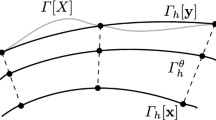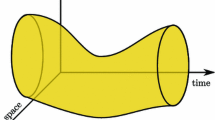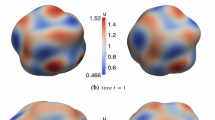Abstract
In this article we define a level set method for a scalar conservation law with a diffusive flux on an evolving hypersurface Γ(t) contained in a domain \({\Omega \subset \mathbb R^{n+1}}\) . The partial differential equation is solved on all level set surfaces of a prescribed time dependent function Φ whose zero level set is Γ(t). The key idea lies in formulating an appropriate weak form of the conservation law with respect to time and space. A major advantage of this approach is that it avoids the numerical evaluation of curvature. The resulting equation is then solved in one dimension higher but can be solved on a fixed grid. In particular we formulate an Eulerian transport and diffusion equation on evolving implicit surfaces. Using Eulerian surface gradients to define weak forms of elliptic operators naturally generates weak formulations of elliptic and parabolic equations. The finite element method is applied to the weak form of the conservation equation yielding an Eulerian Evolving Surface Finite Element Method. The computation of the mass and element stiffness matrices, depending only on the gradient of the level set function, are simple and straightforward. Numerical experiments are described which indicate the power of the method. We describe how this framework may be employed in applications.
Similar content being viewed by others
References
Dziuk G., Elliott C.M.: Finite elements on evolving surfaces. IMA J. Numer. Anal. 27, 262–292 (2007)
Dziuk G., Elliott C.M.: Surface finite elements for parabolic equations. J. Comp. Math. 25, 385–407 (2007)
Dziuk, G., Elliott, C.M.: Eulerian finite element method for parabolic PDEs on implicit surfaces. Interfaces Free Boundaries 10 (2008)
Deckelnick, K., Dziuk, G., Elliott, C.M., Heine, C.-J.: An h-narrow band finite element method for elliptic equations on implicit surfaces (in preparation)
Bertalmio, M., Memoli, F., Cheng, L.T., Osher, S., Sapiro, G.: Variational problems and partial differential equations on implicit surfaces:bye bye triangulated surfaces? Geometric level set methods in imaging, vision and graphics Springer New York, pp 381–397 (2003)
Bertalmio M., Cheng L.T., Osher S., Sapiro G.: Variational problems and partial differential equations on implicit surfaces. J. Comp. Phys. 174, 759–780 (2001)
Greer J.B.: An improvement of a recent Eulerian method for solving PDEs on general geometries. J. Sci. Comput. 29, 321–352 (2006)
Greer J., Bertozzi A., Sapiro G.: Fourth order partial differential equations on general geometries. J. Comput. Phys. 216(1), 216–246 (2006)
Burger, M.: Finite element approximation of elliptic partial differential equations on implicit surfaces. Comput. Visual. Sci. (2007). doi:10.1007/s00791-007-0081-x
Adalsteinsson D., Sethian J.A.: Transport and diffusion of material quantities on propagating interfaces via level set methods. J. Comp. Phys. 185, 271–288 (2003)
Xu J.-J., Zhao H.-K.: An Eulerian formulation for solving partial differential equations along a moving interface. J. Sci. Comput. 19, 573–594 (2003)
James A.J., Lowengrub J.: A surfactant-conserving volume-of-fluid method for interfacial flows with insoluble surfactant. J. Comp. Phys. 201, 685–722 (2004)
Stone H.A.: A simple derivation of the time-dependent convective-diffusion equation for surfactant transport along a deforming interface. Phys. Fluids A 2, 111–112 (1990)
Cahn J.W., Fife P., Penrose O.: A phase field model for diffusion induced grain boundary motion. Acta Mater. 45, 4397–4413 (1997)
Deckelnick K., Elliott C.M., Styles V.: Numerical diffusion induced grain boundary motion. Interfaces Free Boundaries 3, 393–414 (2001)
Fife P., Cahn J.W., Elliott C.M.: A free boundary model for diffusion induced grain boundary motion. Interfaces Free Boundaries 3, 291–336 (2001)
Mayer U.F., Simonnett G.: Classical solutions for diffusion induced grain boundary motion. J. Math. Anal. 234, 660–674 (1999)
Leung C.H., Berzins M.: A computational model for organism growth based on surface mesh generation. J. Comp. Phys. 188, 75–99 (2003)
Jin, H., Yezzi, A.J., Soatto, S.: Region based segmentation on evolving surfaces with application to 3D reconstruction of shape and piecewise constant radiance. UCLA Preprint (2004)
Schmidt, A., Siebert, K.G.: Design of adaptive finite element software. The finite element toolbox ALBERTA. Springer Lecture Notes in Computational Science and Engineering, vol. 42. Springer, Berlin (2004)
Author information
Authors and Affiliations
Corresponding author
Additional information
Communicated by M. Rumpf.
Rights and permissions
About this article
Cite this article
Dziuk, G., Elliott, C.M. An Eulerian approach to transport and diffusion on evolving implicit surfaces. Comput. Visual Sci. 13, 17 (2010). https://doi.org/10.1007/s00791-008-0122-0
Received:
Accepted:
Published:
DOI: https://doi.org/10.1007/s00791-008-0122-0




